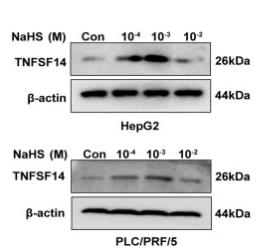TNFSF14 Antibody - #AF0329
| Product: | TNFSF14 Antibody |
| Catalog: | AF0329 |
| Description: | Rabbit polyclonal antibody to TNFSF14 |
| Application: | WB IHC IF/ICC |
| Cited expt.: | WB |
| Reactivity: | Human, Mouse |
| Prediction: | Dog |
| Mol.Wt.: | 26kDa; 26kD(Calculated). |
| Uniprot: | O43557 |
| RRID: | AB_2834173 |
Related Downloads
Protocols
Product Info
*The optimal dilutions should be determined by the end user. For optimal experimental results, antibody reuse is not recommended.
*Tips:
WB: For western blot detection of denatured protein samples. IHC: For immunohistochemical detection of paraffin sections (IHC-p) or frozen sections (IHC-f) of tissue samples. IF/ICC: For immunofluorescence detection of cell samples. ELISA(peptide): For ELISA detection of antigenic peptide.
Cite Format: Affinity Biosciences Cat# AF0329, RRID:AB_2834173.
Fold/Unfold
CD 258; CD258; CD258 antigen; Delta transmembrane LIGHT; Herpes virus entry mediator ligand; Herpesvirus entry mediator A; Herpesvirus entry mediator ligand; herpesvirus entry mediator-ligand; HVEM L; HVEM-L; HVEML; Ligand for herpesvirus entry mediator; LIGHT; LTg; soluble form; TNF14; TNF14_HUMAN; TNFSF 14; Tnfsf14; TNFSF14 protein; TR 2; TR2; Tumor necrosis factor (ligand) superfamily, member 14; Tumor necrosis factor ligand superfamily member 14; Tumor necrosis factor ligand superfamily, member 14; Tumor necrosis factor receptor like 2; tumor necrosis factor receptor-like 2; Tumor necrosis factor superfamily member 14; Tumor necrosis factor superfamily member LIGHT;
Immunogens
A synthesized peptide derived from human TNFSF14, corresponding to a region within the internal amino acids.
Predominantly expressed in the spleen but also found in the brain. Weakly expressed in peripheral lymphoid tissues and in heart, placenta, liver, lung, appendix, and kidney, and no expression seen in fetal tissues, endocrine glands, or nonhematopoietic tumor lines.
- O43557 TNF14_HUMAN:
- Protein BLAST With
- NCBI/
- ExPASy/
- Uniprot
MEESVVRPSVFVVDGQTDIPFTRLGRSHRRQSCSVARVGLGLLLLLMGAGLAVQGWFLLQLHWRLGEMVTRLPDGPAGSWEQLIQERRSHEVNPAAHLTGANSSLTGSGGPLLWETQLGLAFLRGLSYHDGALVVTKAGYYYIYSKVQLGGVGCPLGLASTITHGLYKRTPRYPEELELLVSQQSPCGRATSSSRVWWDSSFLGGVVHLEAGEKVVVRVLDERLVRLRDGTRSYFGAFMV
Predictions
Score>80(red) has high confidence and is suggested to be used for WB detection. *The prediction model is mainly based on the alignment of immunogen sequences, the results are for reference only, not as the basis of quality assurance.
High(score>80) Medium(80>score>50) Low(score<50) No confidence
Research Backgrounds
Cytokine that binds to TNFRSF3/LTBR. Binding to the decoy receptor TNFRSF6B modulates its effects. Acts as a ligand for TNFRSF14/HVEM. Upon binding to TNFRSF14/HVEM, delivers costimulatory signals to T cells, leading to T cell proliferation and IFNG production.
N-glycosylated.
The soluble form of isoform 1 derives from the membrane form by proteolytic processing.
Cell membrane>Single-pass type II membrane protein.
Secreted.
Cytoplasm.
Predominantly expressed in the spleen but also found in the brain. Weakly expressed in peripheral lymphoid tissues and in heart, placenta, liver, lung, appendix, and kidney, and no expression seen in fetal tissues, endocrine glands, or nonhematopoietic tumor lines.
Belongs to the tumor necrosis factor family.
Research Fields
· Environmental Information Processing > Signaling molecules and interaction > Cytokine-cytokine receptor interaction. (View pathway)
· Environmental Information Processing > Signal transduction > NF-kappa B signaling pathway. (View pathway)
· Human Diseases > Infectious diseases: Viral > Herpes simplex infection.
References
Application: WB Species: Human Sample: HCC cells
Restrictive clause
Affinity Biosciences tests all products strictly. Citations are provided as a resource for additional applications that have not been validated by Affinity Biosciences. Please choose the appropriate format for each application and consult Materials and Methods sections for additional details about the use of any product in these publications.
For Research Use Only.
Not for use in diagnostic or therapeutic procedures. Not for resale. Not for distribution without written consent. Affinity Biosciences will not be held responsible for patent infringement or other violations that may occur with the use of our products. Affinity Biosciences, Affinity Biosciences Logo and all other trademarks are the property of Affinity Biosciences LTD.




